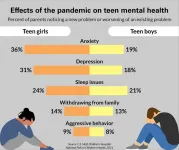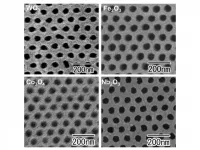(Press-News.org) HOUSTON ? A high rate of genetic mutations within a tumor, known as high tumor mutation burden (TMB), was only useful for predicting clinical responses to immune checkpoint inhibitors in a subset of cancer types, according to a new study led by researchers from The University of Texas MD Anderson Cancer Center.
The findings, published today in Annals of Oncology, suggest that TMB status may not be reliably used as a universal biomarker for predicting immunotherapy response. While TMB status was capable of successfully predicting response to checkpoint blockade in certain cancers, such as melanoma, lung and bladder cancer, there was no association with improved outcomes in others, including breast, prostate and brain cancers.
"This study represents the most comprehensive analysis to date of TMB as a biomarker for response to immune checkpoint blockade," said lead author Daniel J. McGrail, Ph.D., postdoctoral fellow in Systems Biology. "Our results do not support applying high TMB status as a universal biomarker for immunotherapy response, suggesting that additional tumor type-specific studies are needed to clarify how best to apply TMB status in cancer types where it does not appear to be associated with outcomes."
Gene mutations within a tumor lead to the production of mutant proteins, or neoantigens, which can be recognized as abnormal by the immune system. It follows that a high TMB would render tumors more immunogenic, which is why TMB status has become a leading candidate biomarker for predicting immunotherapy response, McGrail explained.
In June 2020, the U.S. Food and Drug Administration approved the anti-PD-1 therapy pembrolizumab for treating patients with advanced and refractory cancers with a high TMB, as indicated by a defined threshold level of mutations. The approval was based on results from the Phase II KEYNOTE-158 study, which found improved overall responses in patients with a high TMB. However, the trial did not include several cancer types, such as breast, prostate and brain cancers, which have not typically responded to immune checkpoint blockade therapy.
"The FDA approval of pembrolizumab for patients with high TMB certainly provides an important option for many patients," said senior author Shiaw-Yih Lin, Ph.D., professor of Systems Biology. "However, we felt that it was important to look more closely at TMB status in a broader group of cancer types and establish approaches to harmonize TMB across various assays to enable clinicians to best utilize the recent FDA approval."
The researchers analyzed over 10,000 tumors across 31 cancer types from The Cancer Genome Atlas (TCGA) to study the relationship between TMB status and tumor immunogenicity, measured by the infiltration of immune cells (CD8+ T cells) into the tumor. They identified two classes of tumors - those with and without a strong correlation between TMB status and T cell infiltration.
The authors predicted that TMB status would not be able to predict immunotherapy response equally in these two groups. They evaluated this using previously published studies and MD Anderson patient cohorts.
For cancers with a strong correlation between TMB status and T cell infiltration, patients with a high TMB had improved clinical outcomes. Across all cancer types in this category, patients with a high TMB had a 39.8% overall response rate to checkpoint inhibitors, which was significantly higher than those with a low TMB.
In contrast, TMB status was not predictive of outcome in the second class of tumors. Within this category, patients with a high TMB had a 15.3% overall response rate, which was actually lower than the response rate for patients with low TMB.
"While TMB status does show value in predicting response to immune checkpoint blockade in several cancer types, this was not generalizable across all cancers," McGrail said. "For those cancer types where a high TMB does not appear to increase immunogenicity, additional prospective studies are needed to determine if TMB status can be an effective clinical biomarker and at what threshold."
Additionally, the researchers found that evaluating TMB status by sequencing a targeted panel of cancer-related genes may overestimate TMB when compared to whole exome sequencing, which offers an unbiased approach. While whole exome sequencing is not feasible in a clinical setting, the threshold for defining high TMB status may need to be evaluated in a cancer type-specific manner, McGrail explained.
The authors note that this study is limited by retrospective analyses across various DNA sequencing approaches, as well as variations in the immune checkpoint inhibitors and clinical outcomes reported across the different cohorts included.
INFORMATION:
A complete list of collaborating authors and their disclosures can be found with the full paper here. This study was supported by the National Cancer Institute (K99CA240689, R01 CA218287), the George and Barbara Bush Endowment for Innovative Cancer Research, the Kidney Cancer Association Young Investigator Award, the Prostate Cancer Foundation Young Investigator Award, the Cancer Prevention & Research Institute of Texas (CPRIT) (RP170668, RP160710, and the Breast Cancer Moon Shot®, part of MD Anderson's Moon Shots Program®, a collaborative effort to rapidly develop scientific discoveries into meaningful clinical advances that save patients' lives.
- 30 -
A large study of people in 28 countries found men aged 50 and over had a 60% greater risk of death than women, partly explained by heavier rates of smoking and heart disease in men, although the gap varied across countries, according to new research in CMAJ (Canadian Medical Association Journal) .
"Many studies have examined the potential impact of social, behavioural and biological factors on sex differences in mortality, but few have been able to investigate potential variation across countries," writes Dr. Yu-Tzu Wu, Institute of Psychiatry, Psychology and Neuroscience, King's College London, and Population Health Sciences Institute, Newcastle University, United Kingdom, with coauthors. "Different cultural traditions, historical contexts, ...
ANN ARBOR, Mich. - For teens, pandemic restrictions may have meant months of virtual school, less time with friends and canceling activities like sports, band concerts and prom.
And for young people who rely heavily on social connections for emotional support, these adjustments may have taken a heavy toll on mental health, a new national poll suggests.
Forty-six percent of parents say their teen has shown signs of a new or worsening mental health condition since the start of the pandemic in March 2020, according to the C.S. Mott Children's Hospital National Poll on Children's Health at Michigan Medicine. Parents of teen girls were more likely to say their child had a ...
PULLMAN, Wash. - People who talk with their doctors are more likely to get vaccinated during a pandemic, according to a study of evidence collected during the "swine flu," the last pandemic to hit the U.S. before COVID-19.
Researchers from Washington State University and University of Wisconsin-Madison surveyed patients about the vaccine for the H1N1 virus, also known as the swine flu, which was declared a pandemic by the World Health Organization in 2009. They found that doctor-patient communication helped build trust in physicians, which led to more positive attitudes toward the H1N1 vaccine--and it was more than just talk; it correlated to people actually getting vaccinated. ...
(COLUMBUS, Ohio) - High-powered magnets are small, shiny magnets made from powerful rare earth metals. Since they started showing up in children's toys in the early 2000s and then later in desk sets in 2009, high-powered magnets have caused thousands of injuries and are considered to be among the most dangerous ingestion hazards in children.
When more than one is swallowed, these high-powered magnets attract to each other across tissue, cutting off blood supply to the bowel and causing obstructions, tissue necrosis, sepsis and even death. The U.S. Consumer Product Safety Commission (CPSC) found them dangerous enough that in 2012 they halted the sale of high-powered magnet sets and instituted a recall followed by a federal rule that ...
A fear of poor SATs results is driving headteachers to separate pupils by ability despite the impact on children's self-esteem and confidence, according to a study by researchers from UCL published in the peer-reviewed British Journal of Sociology of Education.
The findings, based on a survey of nearly 300 principals of primary schools in England, provide new evidence of a high-stakes culture around testing where some pupils are prioritised above others and physically segregated from them.
More than a third (35%) of headteachers said SATs were the reason for grouping children into different ability sets for English, and just under half (47%) for maths, according to the results which also ...
In the world of neurodevelopment, one thing is clear: the earlier the intervention the better. Infancy is a critical time in brain development, and neuroscientists are increasingly identifying factors that can negatively impact cognition and ones that can improve cognition early in life. At the annual meeting of the Cognitive Neuroscience Society (CNS), researchers from the University of Minnesota are presenting new work on two early interventions: one on the potential use of engineered gut microbes for antibiotic-exposed infants and another on a choline supplement to treat infants exposed prenatally to alcohol.
"These talks underscore how patient-based neuroscience can advance ...
Men experiencing vital exhaustion are more likely to have a heart attack, according to research presented today at ESC Acute CardioVascular Care 2021, an online scientific congress of the European Society of Cardiology (ESC).1 The risk of a myocardial infarction linked with exhaustion was particularly pronounced in never married, divorced and widowed men.
"Vital exhaustion refers to excessive fatigue, feelings of demoralisation and increased irritability," said study author Dr. Dmitriy Panov of the Institute of Cytology and Genetics, Novosibirsk, Russian Federation. "It is thought to be a response to intractable problems in people's lives, particularly when they are unable to adapt to prolonged ...
Tokyo, Japan - Scientists from Tokyo Metropolitan University have developed a new method for making ordered arrays of nanoholes in metallic oxide thin films using a range of transition metals. The team used a template to pre-pattern metallic surfaces with an ordered array of dimples before applying electrochemistry to selectively grow an oxide layer with holes. The process makes a wider selection of ordered transition metal nanohole arrays available for new catalysis, filtration, and sensing applications.
A key challenge of nanotechnology is getting control over the structure of materials at the nanoscale. In the search for materials that are porous at this length scale, the field of electrochemistry offers a particularly elegant ...
MRI scanning can more precisely define and detect head, neck, thoracic, abdominal and spinal malformations in unborn babies, finds a large multidisciplinary study led by King's College London with Evelina London Children's Hospital, Great Ormond Street Hospital and UCL.
In the study, published today in Lancet Child and Adolescent Health, the team of researchers and clinicians demonstrate the ways that MRI scanning can show malformations in great detail, including their effect on surrounding structures. Importantly, they note that MRI is a very safe procedure for pregnant women and their babies.
They say the work is invaluable both to clinicians caring for babies before they are born and for teams planning care of the baby after delivery.
Recent research has concentrated ...
The Affordable Care Act (ACA) dramatically increased children's preventive healthcare while reducing out-of-pocket costs, according to a new Boston University School of Public Health (BUSPH) study.
Published in JAMA Network Open, the study found that checkups with out-of-pocket costs dropped from 54.2% of visits in 2010 (the year the ACA passed) to 14.5% in 2018.
"This is a great feather in the cap of the ACA, even though there is still some work to do," says study lead author Dr. Paul Shafer, assistant professor of health law, policy & management at BUSPH.
"We found ...


